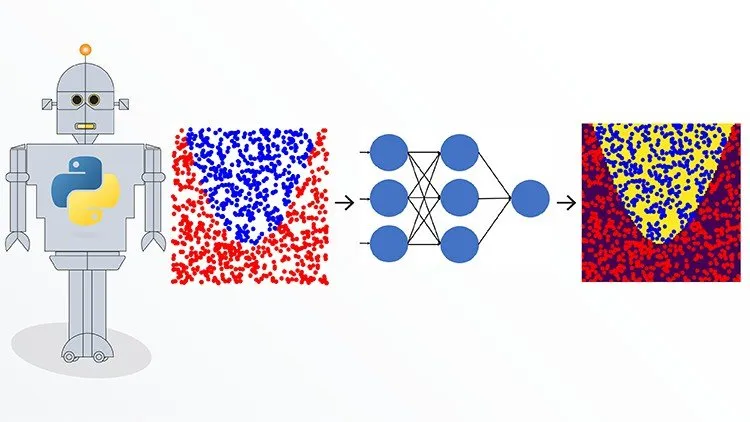Introduction to Machine Learning
Linear and Logistic Regression and Neural Networks Using Python

Introduction to Machine Learning udemy course
Linear and Logistic Regression and Neural Networks Using Python
What you'll learn:
- Genuinely understand what Computer Science, Algorithms, Programming, Data, Big Data, Artificial Intelligence, Machine Learning, and Data Science is.
-
To understand how these different domains fit together, how they are different, and how to avoid the marketing fluff.
-
The Impacts Machine Learning and Data Science is having on society.
- To really understand computer technology has changed the world, with an appreciation of scale.
- To know what problems Machine Learning can solve, and how the Machine Learning Process works.
- How to avoid problems with Machine Learning, to successfully implement it without losing your mind!
Requirements:
- A passion to learn, and basic computer skills!
- Students should understand basic high-school level mathematics, but Statistics is not required to understand this course.
Description:
Course Outcome:
After taking this course, students will be able to understand and implement machine learning algorithms using Python for regression, binary classification, and multi-class classification with applications to real-world datasets.
Course Topics and Approach:
This introductory course on machine learning focuses on Supervised Learning, which involves finding functions that fit data and then using the functions to make predictions. Applications include image classification, text sentiment classification, house price prediction.
The core of this course involves study of the following algorithms:
Linear Regression, Logistic Regression, Neural Networks for regression, binary, and multiclass classification
Unlike many other courses, this course:
Has a detailed presentation of the the math underlying the above algorithms including optimization algorithms and back propagation formulas
Has a detailed explanation of how algorithms are converted into Python code with lectures on code design and use of vectorization
Has homework questions (programming and theory) and solutions that allow learners to get practice with the course material
The course codes are then used to address case studies involving real-world data including image classification, text message spam/no spam classification, and house price prediction.
Course Audience:
This course is designed for:
Scientists, engineers, and programmers and others interested in machine learning/data science
No prior experience with machine learning is needed
Students should have knowledge of
Basic linear algebra (vectors, matrix multiplication, transpose)
Multivariable calculus (to follow details of optimization and backpropagation formulas)
Python 3 programming
Students should have a Python installation, such as the Anaconda platform, on their machine with the ability to run programs in the command window and in Jupyter Notebooks
Teaching Style and Resources:
Course includes many examples with plots used to help students get a better understanding of the material
Course has 50+ exercises with solutions (theoretical, Jupyter Notebook, and programming) to allow students to gain additional practice
All resources (presentations, supplementary documents, demos, codes, solutions to exercises) are downloadable from the course Github site.
Who this course is for:
- Students without any previous experience with machine learning
- Students with previous experience who would like to revisit the math, algorithms and coding for machine learning in detail
- Total SEO Blueprint - Google #1 Rankings Made Easy
- Advanced SQL and PostgreSQL: The Complete Developer's Guide
- Practical Password cracking - Office files | Ethical Hacking
- The Complete Web Development Course with PHP, PDO & MySQL
Course Details:
- 14.5 hours on-demand video
- 33 downloadable resources
- Full lifetime access
- Access on mobile and TV
- Certificate of completion
Introduction to Machine Learning udemy free download
Linear and Logistic Regression and Neural Networks Using Python
Demo Link: https://www.udemy.com/course/introduction-to-machine-learning-using-python/
